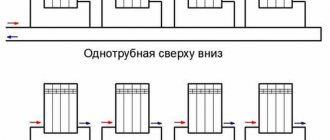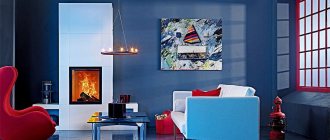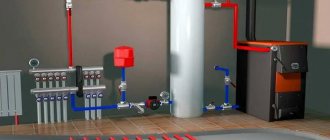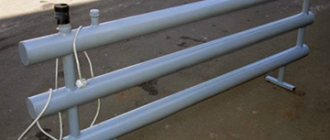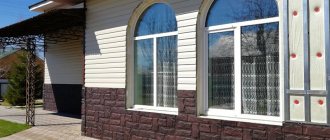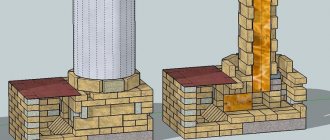Houses made of wood are actually the first artificial housing created by man. There is a gap of thousands of years between the first tree trunk huts and stone structures. There is something primitive, real and native in wooden houses: perhaps this is why their popularity not only does not fade, but is steadily growing. Naturalness, environmental friendliness, good thermal insulation properties and unsurpassed aesthetics are the main advantages of such buildings. Are there enough of them to call such housing ideal? Quite - if the installed heating of a wooden house is efficient and safe.
- 2 Gas heating
- 3 Liquid fuel - an alternative to “blue”
- 4 Electricity: simple, convenient, but unprofitable?
- 5 Solid fuel boiler: a practical solution
- 6 Stove - never losing its relevance
- 7 Safety, accessibility, comfort
Types of heating systems
To organize space heating, you can use several heat sources at once. Heating installation in a wooden house can be done using the following heat generators:
- bake;
- fireplace (classic or modernized);
- gas convector;
- electric convector;
- heat gun.
When choosing a suitable option, it is worth considering how light and easy it will be to operate. The cost of equipment maintenance becomes an important factor; sometimes incorrect calculations lead to unnecessary costs. The same applies to reducing heat losses to a minimum. An important role when creating heating in a wooden house with your own hands is played by the aesthetic appearance of the units and their compliance with the chosen interior.
Installation of a chimney in a wooden house
If you have already decided to make gas heating at home with your own hands or with the help of specialists, then you need to know that according to fire and gas safety requirements, the boiler room must have a chimney and an exhaust hood.
If you have a gas boiler with an open combustion chamber, then the chimney must be vertical and large-sized. If the boiler has a closed combustion chamber, then a bulky chimney is not needed. A boiler of this type uses forced draft, so a pipe with a diameter of 10 cm will be needed to remove combustion products. The hole for this pipe must be lined with non-flammable material. The air for the burner will come from outside, so there will be no need for constant ventilation of the room (as with a boiler with an open combustion chamber).
Article on the topic: How to insulate the roof of a wooden house
Since the house is wooden, there is no way to create channels inside the walls. Therefore, an insulated metal chimney (“sandwich”) is very often used. The hood is also made from this type of pipe. Often these channels lead directly to the street, and rise up along the outer wall. This works effectively, but there are a few problems.
If there are severe frosts in your area, then the chimney insulation may not cope with its task. So, the air inside the pipe cools down and then falls down, thus plugging the chimney and hood, or even creating a draft in the opposite direction. This leads to the fact that the gas water heater for heating the house stops in emergency mode or the boiler room gets cold. Therefore, if you use sandwich type pipes, then place them in the part of the building that is heated, and only a small part will be discharged to the roof.
A good option is built-in or attached brick chimneys. If you decide to use just such a chimney, remember that the walls inside must be plastered.
Distinctive features of pumping systems
The movement of the coolant at a suitable speed is ensured by a special pump. This helps to avoid temperature loss and also leads to faster heating of the premises.
A common system is a system with natural water circulation. Due to the difference in pressure, the liquid returns to the boiler after cooling. The warming up process is carried out more slowly, but the cost of installing a system of this type is more affordable for a wide range of buyers.
High efficiency can be achieved by installing a circulation pump. The use of such a system makes it possible to use pipes of smaller diameter. With natural circulation, the volume of heated space is limited; when operating a circulation pump, there are no space restrictions. Additional equipment requires money to be spent at the purchase stage, but the efficiency of its use will reduce fuel consumption, so it will bring tangible benefits.
Heat supply system (heat supply)
The first thing you need to pay attention to when selecting is the type of heating supply to the house. The following thermal schemes are possible:
The following thermal schemes are possible:
- From a centralized heat source - if you do not plan to travel far outside the city or are building within a cottage community, then you can use the existing heating network of a thermal power plant or boiler house, which provides heat to nearby houses.
- From a local heat source (autonomous heat supply) – heat supply comes from our own boiler house. This method is used if the heating network pipelines are located far away.
The main pros and cons of heat supply schemes.
| Heat supply | Advantages | Flaws |
| Centralized | No need for a boiler room (no costs for a boiler, pump, water heater), environmental friendliness | Dependence on the heat source, costs of laying the heating main |
| Autonomous | Switching on, switching off and regulating the system at will, independence from the seasonal operation of the thermal power plant/boiler house | You need a boiler room (all equipment in the boiler room), a chimney, a fuel warehouse, emissions into the atmosphere |
I talk in more detail about heat supply systems in the video below.
Heating boiler diagram
Water heating in a wooden house cannot be imagined without a boiler that provides heating of the coolant. The boiler is a device operating in automatic mode. There are several types of equipment that use different types of fuel.
Heating boiler diagram
The heating system in a wooden house can be installed using the following types of boilers:
- gas;
- electrical;
- diesel;
- working on solid fuel.
It is worth considering separately the features and types of infrared heating. This model of heating system uses electricity to operate, and at the same time has economical consumption compared to electric boilers. The disadvantage of this option is the inability to heat large rooms; often infrared equipment plays a supporting role.
Drawing up a heating scheme
Since water is predominantly used as a heat carrier, the schemes discussed below will be based on this factor. The essence of this kind of heating system for a wooden house is that the liquid is heated in a boiler and passes through pipes into radiators, where it is cooled. Next, the water returns to the heat source.
Installation of a one-pipe system
The choice of scheme largely depends on whether a system with gravity or forced coolant pumping is used. In addition, when drawing up a project, you need to take into account the number of circuits.
When organizing a single-pipe building heating system, it is almost impossible to regulate the temperature. It will be different in any case. The farther from the boiler, the lower the temperature
The advantage of creating one heating circuit is ease of installation. If you stick to the plan, you can quickly get the job done without involving a professional.
The single-pipe system allows you to save plumbing fixtures. And in order to maximally equalize the temperature throughout the entire circuit, it is necessary to increase the number of radiator sections that are connected at the end. To speed up the water flow, it is recommended to install a pump.
You should choose a single-pipe system only if it is possible to install the boiler below the level of the radiators. Otherwise, water will not circulate through the pipes
Subtleties of organizing two-pipe heating
A system with two circuits allows you to maintain the same temperature in all radiators, which will have a beneficial effect on heating efficiency. The disadvantage of this solution is the high consumption of materials.
The diagram of a two-pipe house heating system is also suitable for heat generators that run on solid fuel. The only thing that needs to be adjusted in this case is the pipeline material
When implementing a two-pipe project, each radiator must be equipped with shut-off valves. Such elements will allow you to adjust the temperature in each room.
If the boiler will be installed in the basement, then the best choice is a system with bottom wiring (the diagram is presented below). This solution is ideal for wooden houses where a gas boiler is used as a heat generator.
Gas boilers
If it is possible to connect to a gas pipeline, a gas boiler in a wooden house will be a good option. There are three types of boilers:
- atmospheric (a distinctive feature is a constant combustion mode, but when heated to a certain level, the gas supply automatically stops);
- turbine (in many ways similar to atmospheric, the difference is the presence of an air mass control system);
- condensation (has a more complex structure, in it the condensate located on the surface of the combustion chamber is first heated, which subsequently heats the coolant).
Gas boilers
Condensing boilers from Germany are characterized by high energy efficiency; they have decent efficiency. The only reason to refuse such equipment is the need to install heating in a wooden house without gas.
Calculation of the number of sections
It is not necessary to look for the most expensive heating devices to make the room comfortable. The main thing is to correctly calculate the number of sections. If the rooms are standard, then this greatly simplifies the calculations.
Often they resort to calculations based on the volume of space because they are simple, but at the same time give fairly accurate results.
- 1 m³ requires 41 W of power. If good double-glazed windows are installed and heat loss is minimal, then the indicator drops to 34 W.
- Room volume (m³) = area (m²) × height (m).
- Required heating power for the entire room (W) = room volume (m³) × 41 W (or 34 W).
- In the technical data sheets of devices, manufacturers indicate the heat transfer of one section.
- The total power (the value calculated in point 3) must be divided by the heat transfer of one section. The resulting number is the number of sections.
For example, the required thermal power is 2890 W, and the heat output of one section is 170 W. Then for this room you need to purchase 17 sections.
In a non-standard room, calculations are made using a more complex formula Source rmnt.mirtesen.ru
If the room is non-standard, the calculations become more complicated. To calculate the total power, the features of double-glazed windows (double or triple), thermal insulation parameters of the walls, the ratio of the sizes of windows and floors, ceiling heights and other parameters are taken into account. Designers calculate all this using specialized software.
Electric boilers
Electric heating in a wooden house involves the use of two boilers, one of which performs only an auxiliary function. The main boiler is a model in which the heating element function is performed by a heating element (tubular electric heater). In some cases, an electric boiler with electrodes is used; its operation is carried out using the ionization of water molecules.
Electric boilers
Before choosing electric heating in a wooden house, it is worth considering the subsequent costs. The equipment itself is inexpensive, but the price of electricity may scare off potential buyers. This method has advantages:
- small size of the unit;
- complete safety of use;
- possibility of autonomous operation (without human intervention);
- Efficiency is close to 100%.
Replacing the battery
The device is equipped with a lithium battery ER14250 or CR2032. Possible replacement options are given in the user manual.
To replace you will need:
- Remove the terminal compartment cover secured with screws on the front side.
- Dismantle the electronic unit in the same way.
- Remove the used element by soldering a new one.
- Reassemble the device in reverse order.
After completing the work, the organization that changed the battery indicates this fact in the corresponding section of the meter passport.
Date: September 25, 2022
Solid fuel boilers
If the cost of electrical energy is unaffordable and there is no possibility of connecting to gas, the best choice would be a solid fuel boiler in a wooden house. There are various models of equipment with different firebox heights. One load of fuel allows the unit to operate autonomously for up to 12 hours. The most popular types of fuel are coal and wood. This type of boiler is the most profitable in terms of operating cost.
Solid fuel boilers
The disadvantage of heating in a private house using solid fuel boilers is the dependence of the efficiency on the level of humidity. You should not choose too cheap models, otherwise you will have to deal with such troubles as the formation of soot and soot. Most inexpensive boilers require frequent cleaning, which takes a lot of time.
Heating radiator classes
The classification of heating radiators can be indicated by the following list:
- sectional;
- tubular;
- panel;
- lamellar.
Sectional
The design of this class of batteries is a combination of two or more hollow flow vessels (sections) in one radiator. The number of sections varies depending on the thermal design of the room. They come in both aluminum and cast iron models.
pros
The advantage of such heating devices is that you can always increase or decrease their heat output (see table) by adding or removing sections. To assemble the battery sections, you will need external thread fittings (nipples), O-rings, connecting pipes and a special wrench. Sectional heating devices can quickly be disassembled into separate sections or assembled into a reliable product.
Minuses
The structure, consisting of several elements, has many connecting points. Loose connections can result in battery leaks.
Tubular
Tubular radiators began to be installed back in the 30s of the last century. They have always been considered piecemeal devices. That is, they are supplied to the customer on an individual order. This class of batteries enjoys the greatest success among designers. Steel radiators can be either with horizontal or vertical tubes.
pros
Like all custom-made products, tubular steel appliances are in demand among owners of expensive country mansions.
The use of any bold design solutions makes it possible to install tubular radiators not only as heating devices, but also to make them one of the bright accents in the interior of any room. The thermal characteristics of steel products are high.
Minuses
The disadvantages of tubular heaters for an autonomous heating system include inaccessibility for most consumers due to the high price of the products, and “capriciousness” in relation to the quality of the coolant (coarse and fine filters must be installed).
It should also be noted that this class of batteries refers to non-separable devices, and partial replacement of individual segments is impossible.
Panel
Screen heaters are also non-separable devices. The look of solid panels, painted mainly in neutral tones, is in fairly high demand among ordinary consumers.
Rectangular steel radiators consist of 2 parallel steel planes welded to each other, inside which U-shaped tubes are located. Steel strips are placed along the perimeter of the ends of the battery. The panels can be either with a side or bottom coolant supply.
pros
Panel steel radiators have high heat transfer characteristics, they are compact and their appearance harmonizes with any interior of the room. Panel appliances are especially popular in private homes with large window openings.
Long screen heaters are placed in niches or simply under windows so that they cut off the cold influx of the external atmosphere from penetrating into the premises.
Minuses
Panels that have been subjected to water hammer or mechanical damage with rupture of the steel surface cannot be repaired. Batteries cannot be disassembled and their dimensions cannot be adjusted. The devices look quite monotonous in appearance.
Lamellar
They can, in some cases, be classified as bimetallic types of batteries and converter devices. The idea of the design is that a steel pipe with coolant is placed through a set of thin steel, aluminum or copper plates.
pros
The more petals, the larger the heat transfer area. Therefore, a small-looking device in a private house will heat a room just as effectively as its much larger panel, sectional or tubular counterparts. The trouble-free service life is 20 years or more.
Minuses
The main disadvantage of plate heaters is that the plates, with their area, increase not only the heat transfer of the device, but also attract a large amount of dust.
Accumulations of lightly suspended particles in a private home can cause allergic reactions in people present in the room. Therefore, batteries of this type need to be cleaned regularly with a vacuum cleaner.
Diesel boilers
One of the common options for heating a wooden house is purchasing a diesel boiler. The advantage of such systems is their ease of installation and subsequent operation. When installing most models, you do not have to worry about the need to create a complex chimney system.
Diesel boilers
When using water heating, such equipment will have a number of disadvantages:
- high fuel consumption (15 liters per day) and corresponding maintenance costs;
- low efficiency rate (from 75 to 85%);
- the need for constant monitoring (if bad fuel is used, work may simply stop).
Among all the options, this one has the lowest efficiency and the need for constant monitoring, however, quick heating of the room and the ability to regulate the temperature make the installation of a heating system of this type popular. You can also choose a diesel boiler if fuel costs do not become a serious problem for you.
Criteria for choosing a heat generator
There is simply a huge selection on the market - domestic and foreign manufacturers offer a wide variety of models. From such an assortment, a buyer with any income level will be able to choose something for himself.
In order not to make a mistake when buying a boiler, you need to check what type of fuel is most available in the region. It is also important to correctly calculate the power of the equipment.
Advantages of gas units
The vast majority of owners of wooden houses opt for gas equipment.
The popularity of wall-mounted and floor-standing gas boilers is due to the fact that such fuel is one of the cheapest in many countries. In addition, with its help you can organize a completely autonomous and maintenance-free heating system.
The list of advantages of gas boilers needs to be supplemented:
- High efficiency . Even a low-power device generates more heat than its counterparts running on other types of fuel.
- Ease of operation . No need to worry about where the fuel will be stored. At the same time, using such equipment is easy - you only need to set it up once.
- Durability . A high-quality gas unit will last at least 15 years.
The main disadvantage is the need to obtain special permission to install it. All other disadvantages are completely offset by advantages.
If you need to heat a large house with an area of more than 100 m2, then it is better to refuse a gas boiler. In this case, it will be an economically unprofitable solution
Diesel component in the system
Diesel-powered equipment has become increasingly popular over the past few years. First of all, liquid fuel boilers are cheap to maintain and easy to install.
At the same time, there is no need to organize a complex chimney design - many models run on light heating oil. The only thing required is to organize the pipe outlet in the form of a sandwich. It has a special turbine that pushes out air.
If you have decided to install a diesel boiler, you need to understand that this heating method will be expensive. After all, the efficiency of this equipment varies from 75 to 85%, which is a rather low figure.
Also, a diesel-powered unit requires constant monitoring. If it is left for at least a week, it will lead to problems. Indeed, due to the low quality of fuel, the equipment may stop. As a result, the water in the pipes will freeze and burst.
Even despite all the advantages of a diesel device, it should only be installed if this is the only available way to organize a heating system
Solid fuel boiler
This type of equipment is as popular as gas equipment. Great demand is due to the efficiency and environmental friendliness of solid fuel boilers. After all, such a device is the cheapest device to operate. At the same time, it burns renewable fuel and is highly energy efficient.
The market offers an impressive selection of solid fuel boilers. Savings in this matter are not always justified - if you decide to buy the cheapest model, you need to be prepared for the appearance of soot, soot and come to terms with the need for frequent cleaning.
The only disadvantage of solid fuel boilers is the need to allocate space for storing fuel, which requires quite a lot for its operation
Electric heat generator
Equipment that uses current in its operation is the only solution for those regions where centralized communication systems are not installed. Most often it is used as an additional option.
Today, manufacturers offer a wide range of electric boilers. Models with power from 6 to 30 kW are available on the market. Such a wide range of performance allows you to order the device for a wooden house of any size.
Advantages of the equipment:
- small dimensions;
- operational safety;
- complete autonomy;
- cheapness;
- Efficiency approaching 100%.
But keep in mind that electricity is the most expensive energy carrier. Therefore, even despite the low cost of the unit, operating such a system will be expensive.
Electric boilers are completely safe for a wooden house. But to avoid problems, you need to install a meter and select a cable with a calculation of 8 amperes per 1 mm2 of its cross-section
Power calculation rules
To determine the optimal performance of the boiler, it is not at all necessary to seek help from a specialist. To do this, you only need to determine the amount of heat loss. Knowing this value, it must be multiplied by the area of the house and the resulting number will be the required power.
If the building is not insulated in any way, then heating one square meter will require from 130 to 200 W. For buildings with old windows and a facade that is covered with material that does not allow cold to pass through, the optimal value will be 90-120 W/m2.
As for houses with good thermal insulation of attic and basement floors, plastic double-glazed windows, insulated doorways, properly arranged air exchange, then 50-80 W/m2 will be enough to heat them.
Warm floor
Modern homes often use underfloor heating to create a more comfortable environment. If the power is correctly calculated, such a system can be used as a method of heating rooms if there is no severe frost outside. When using a water system, pipes are laid under the final coating, thereby heating the surface.
Warm floor
If you use an electric heating connection in a wooden building, you should definitely install heated floors. This will increase consumption slightly, but the increase in comfort will be clearly felt.
Underfloor heating is rarely used separately as heating; most often it is part of a combined system. When installing, take into account the need for additional thermal insulation to comply with fire safety regulations. Before installation, it is worth taking care of the possibility of temperature control in order to control the condition of the system.
Using solar energy
If you live in a sunny region of Russia, then solar panels will be an excellent solution for you, which will generate heat and heat water most of the year. You won’t have to pay utility bills every month, and the heat will be taken “out of thin air.” This is suitable for owners of summer cottages that are used only periodically, for example, for planting crops in the garden and for a summer holiday in a cozy country house. Consumers who install such systems are not afraid of power outages. You can also use photovoltaic panels, which are used as an additional power source. If there are power outages, the energy from such devices will be enough to keep boilers and heaters running for several hours, as well as watch TV and charge your phone.
Contrary to all stereotypes: a girl with a rare genetic disorder conquers the fashion world. This girl's name is Melanie Gaydos, and she burst into the fashion world quickly, shocking, inspiring and destroying stupid stereotypes.
11 Weird Signs That You're Good in Bed Do you also want to believe that you please your romantic partner in bed? At least you don't want to blush and apologize.
7 Body Parts You Shouldn't Touch with Your Hands Think of your body as a temple: you can use it, but there are some sacred places that you shouldn't touch with your hands. Research showing.
9 Famous Women Who Have Fallen in Love with Women Showing interest in people other than the opposite sex is not unusual. You are unlikely to be able to surprise or shock anyone if you admit it.
10 charming celebrity children who look completely different today Time flies, and one day little celebrities become adults who are no longer recognizable. Pretty boys and girls turn into...
20 photos of cats taken at the right moment Cats are amazing creatures, and perhaps everyone knows this. They are also incredibly photogenic and always know how to be in the right place at the right time.
Options for choosing the right system
It is impossible to talk about a clear advantage of one system over all others; in a particular case, your own option is optimal. The following factors should be taken into account:
- cost of equipment;
- cost of radiators and other consumables;
- operating and maintenance costs;
- efficiency;
- exercising control;
- frequency of residence in the house (all year round or only in warm weather);
- types of thermal media used.
Each factor must be taken into account to make an informed decision. Do not forget about the aesthetic component of the question of how to hide and conceal heating pipes. All potential problems should be considered at the stage of choosing the type of system. Do-it-yourself heating schemes for a wooden house allow everyone to carry out installation independently without the involvement of third parties.
Radiator prices
The cost of heating devices varies significantly depending on the following factors:
- brand and country of origin;
- material and production technology;
- design.
Italian, German, Finnish, and Czech batteries are more expensive than Russian ones, but in terms of their technical and operational characteristics, products from domestic manufacturers are not much inferior and even superior to many foreign analogues.
Buying heating radiators for a private home is quite expensive. But if you make the right calculations and select cost-effective devices, then costs can be significantly reduced.
The average cost of aluminum radiators per section is in the range of 1227–8200 rubles, bimetallic devices – 3000–11900 rubles. The cheapest of them can be purchased at a price of 1100 rubles. The range of prices for steel radiators is also quite wide: from 830 to 60,000 rubles. Steel models costing from 3,500 to 26,000 rubles are popular. Inexpensive cast iron batteries can be purchased for 500–1000 rubles. Cast iron appliances are in demand for RUR 3,000–8,000.
Retro-style batteries can be found from 8,000 rubles.
If batteries are needed for an entire house, then even inexpensive devices cost a pretty penny. In addition, costs will be added for related products: valves, thermostat heads, brackets and other parts.
Types of thermal media
Thermal energy can be transferred in various ways; the following options can be considered:
- air heating of a wooden house;
- using water (the most popular option);
- stove heating in a wooden house;
- underfloor heating systems.
We have already discussed the underfloor heating system above; it will not be able to fully provide the house with heat in the winter. This option is used as part of a system with different coolants or when living in a cottage only in the summer.
Water is most often used as a coolant for many reasons. This is the easiest way to provide room heating; the system will have high performance and efficiency.
Stoves for heating a wooden house are a traditional option for heating rooms. This method has been tested by time; in our time, it remains in high demand. Stove heating in a wooden house is sometimes not capable of heating distant rooms, which becomes a serious drawback. However, when combined with other options, the stove demonstrates good efficiency indicators.
The use of air as a coolant is also often used. It is relatively safe; the downside is often significant heat loss during long-distance transmission. If you plan to heat houses with a large area, you will have to think about a way to avoid a drop in temperature when moving.
Separately, it is worth noting quartz heating, which is more economical compared to classic electric heating systems. Quartz equipment consumes several times less electricity, while being able to heat rooms in a short time.
The good old method of stove heating
Stove heating
Stove heating is one of the old means of heating indoor air. This type of heating today can be made on the basis of solid fuel, as well as using electricity. The latter is an innovative solution. In this case, heat comes from heat generators with forced and natural draft. Many people associate stove heating with wood. One of the modern developments of this kind involves a project for a fireplace and a brick stove, for example, “Buleryan”. However, in addition to firewood, you can use other heat sources, such as coal.
When installing stove heating, it is important to take into account all the instructions of SNIP. In this case, it is recommended to use it for heating a one-story and two-story house, not counting the basement. The surface of the furnace should not be allowed to heat up to temperatures above 1200° C.
When building such a heating system, you will most likely need the help of a qualified specialist, since not everyone knows how to properly lay out the firebox.
What can you save on?
When purchasing equipment and installing a heating system, the issue of saving invariably arises. Correct calculations of power will allow you to spend less money, while in terms of comfort you will not lose anything. For example, there are several options for installing a gas boiler in a wooden house. The heat exchange pattern and overall efficiency depend on its location.
The efficiency of the system depends on how good the heating radiators are, which ones are best to use in a particular situation, calculations will show. These elements may have different designs. A massive element will not be highly efficient if you need to heat a small room. Radiators according to the type of material used are divided into the following types:
- aluminum (they can be cast or obtained as a result of processing a workpiece);
- panel steel (ease of installation, efficiency of use);
- cast iron products (they take a long time to heat up, but can be used for more than half a century);
- tubular steel;
- modern bimetallic structures.
If gasification is present, you should first consider options using gas for heating. Options may vary in cost; you can always choose the best option for a particular case. It is possible to install a stove under a gas boiler, which will make your life more comfortable.
Trusted manufacturers
On the Russian heating engineering market there is a wide range of heating radiators, the manufacturers of which are known for their quality products.
The best radiators are presented by several well-known manufacturers.
Aluminum
Among products of this type, two manufacturers worth noting are Global ISEO and Royal Thermo Revolution.
DO NOT BUY Radiators Until You See THIS!!!
Global ISEO
The Italian company Global ISEO has been manufacturing aluminum radiators for more than fifty years. Elegant products fit harmoniously into window sill niches and look great in the open. The model range is represented by devices with different numbers of sections. The average price of a radiator of 8 sections is 5.2 thousand rubles, of 10 sections – 10.2 thousand rubles.
Royal Thermo Revolution
This brand has established itself as a manufacturer of reliable products at an affordable price. Impeccable design, increased power, resistance to water hammer and a 10-year warranty - all this indicates the high quality of aluminum batteries. The average price of a Royal Thermo Revolution radiator with 10 sections is 10.8 thousand rubles.
Steel
The best steel radiators are represented by manufacturers such as Kermi and Buderus.
Radiator in the heating system of a private house.
Kermi
The Kermi brand presents one of its best steel batteries, the Kermi FKO 22 with side connection. German products are made from high-quality low-carbon steel. Thanks to this, radiators are characterized by high performance.
All devices are supplied with a complete set of brackets, plugs and an air valve. The average price of a 500 x 800 mm panel is 6.3 thousand rubles.
Buderus
The German company is one of the manufacturers of high-quality products such as steel panel heating radiators. One of the best models, Buderus Logatrend VK-Profil 22, is made by roller welding.
The devices have an elegant appearance and are designed for 50 years of trouble-free service. The average price of this model measuring 500 x 600 mm is about 5 thousand rubles.
Cast iron: MS-140 and GURATEC Apollo 970/05
The budget version of cast iron products is presented by the Lugansk Foundry and Mechanical Plant. They are preferred to be installed in public places and non-residential premises. The cost of one battery from section 5 of MS-140 with a height of 800 mm is on average 2.7 thousand rubles.
The German company Guratec is considered one of the best foreign manufacturers of cast iron batteries. The products are made in retro style. The products are expensive because each device is a unique work of art with painting and monograms in a wide color range. A cast iron radiator GURATEC Apollo 970/05 will cost the buyer about 90 thousand rubles.
Bimetal: SIRA GLADIATOR 500x4 and ROYAL Thermo Revolution Bimetall 350
In the heating engineering market, the Italian company Sira Group is known for its high-quality Gladiator bimetallic radiators. The wide range of products includes models Alfa Bimetal, Gladiator, RS Bimetal, etc. The average price of a bimetallic radiator model SIRA GLADIATOR 500x4 is about 3.6 thousand rubles.
Bimetallic devices ROYAL Thermo Revolution Bimetall 350 are of high quality. The main advantage is a seven-layer anti-corrosion coating, which allows the batteries to be used in rooms with high humidity levels (gyms, swimming pools, etc.). The average cost of a 60 x 415 mm radiator is 8.3 thousand rubles.
Vacuum: EnergyEco
The Russian company EnergyEco is considered one of the best manufacturers of vacuum heating radiators. The devices are made of 1.5 mm steel. The heat output of 1 section is 170 kW. The average price of a lithium bromide flow radiator of 10 sections is 7 thousand rubles.
Quartz: TeplEco
Judging by the 2022 ratings, the Russian company TeplEko was named the best manufacturer. Quartz panels can be installed in rooms with high humidity. For a bathroom, a 400W stove will provide a comfortable air temperature. A quartz monolithic slab measuring 600 x 350 x 25 mm costs an average of 2.6 rubles.
Heating system installation
Self-installation forces you to take into account the following operating features:
- installation of special compensators;
- selection of material for pipelines and radiators;
- correct connection of all elements so that there are no leaks;
- wiring on all floors, reducing the number of risers to a minimum.
Installation of a heating system
It is worth deciding where the boiler room will be located in a wooden house. For its arrangement, basements or a separate extension can be used. There are always different options for how to attach a boiler room to a wooden house, differing in the cost of installation, the complexity of the work and the ease of subsequent operation.
Types of heating radiators for a house made of timber
To install a water heating system for a house made of timber, in addition to boilers, it is necessary to select the most suitable pipes, connecting fittings and radiators. The modern heating equipment market offers a wide selection of different types of batteries. Sectional radiators continue to be the most popular. For their production, materials such as cast iron, steel and aluminum alloys can be used. The most recent developments in the field of heating equipment include bimetallic radiators.
Cast iron is a traditional material for the production of heating batteries. Products made from it are distinguished by their heavy weight and high thermal inertia. Cast iron radiators are attractive due to their reliability and long service life.
Modern cast iron batteries differ from traditional Soviet models in a more attractive design.
Aluminum radiators are light in weight, but do not withstand pressure drops in the system and are therefore considered not reliable enough. Bimetallic batteries are made from steel and aluminum, so they combine the best characteristics of these materials. The aluminum body can significantly reduce the weight of the structure, and steel pipes transfer heat well and are reliably protected from corrosion. The presence of a large selection of different radiator models creates certain difficulties for buyers when choosing products for heating a house made of timber. To avoid making mistakes, it is worth consulting with experienced specialists who are well acquainted with modern heating equipment at the heating design stage. Special attention should be paid to the qualified installation of such systems.
Single pipe system
The heating system can have a different number of circuits; the single-pipe version is most common. A single-pipe system ensures that hot water rises due to the difference in mass and density with the colder part of the coolant.
Single pipe system
This option is best used for small houses, since with natural circulation the difference in temperature on different floors will be felt. A good way to get rid of this drawback is to use a circulation pump. It is worth calculating all the expenses to understand whether this option will have truly suitable efficiency.
What to consider when choosing a radiator for a private home
One of the advantages of a private house is an autonomous heating system, which is calculated and installed according to the individual wishes of the owner of the house. The question of which radiators are best for a private home is easier to answer than when choosing radiators for an apartment connected to the central heating network of a microdistrict.
Unlike the central heating system of city apartments, the closed system of a private house has the following positive characteristics:
- operates at low pressure and it is possible to create a favorable operating environment;
- there are no such huge water hammers, thanks to this the range of choice of radiators offered by the market is significantly expanded;
- subject to the technical conditions of the acid balance of water, the list of radiator selections is quite extensive.
Taking into account the above-mentioned positive characteristics of an autonomous home heating system, the main emphasis in choosing radiators for it should be on the maximum heat transfer coefficient and a good price-quality ratio. By and large, any radiators, steel, aluminum, bimetallic and even cast iron, can be used for operation in a closed home heating system. But some points still need to be taken into account, which read further.
Two-pipe system
If there are two circuits, the hot coolant enters the radiators through a separate line. This ensures faster heating of the rooms, as well as the same temperature in opposite parts of the building. In large houses, uniform heating is important, so this option is optimal there.
Two-pipe system
Sometimes there is a need to expand the house and make new extensions. When using a double-circuit heating system, this will not be a problem; such a system is considered scalable, that is, you can always extend any line. When building houses with a large area of premises, opt for a two-pipe system.
How to calculate power
The power of any radiator for an individual home is calculated based on the fact that to heat an average room with one window, one door and a shelf height of less than three meters, the coolant temperature should be about 70 degrees, and to heat one square meter you need 95-125 kW. The parameters of this scheme are adjusted if real conditions differ from the average: in a room with second light, the battery power should be greater by as many times as the ceiling height is higher than average; if the ceilings are low, the power is reduced.
If the coolant temperature is less than 70 degrees, then the power of the radiators should increase (15-20% for every 10 degrees). In corner rooms with several windows, the average radiator power is increased by one and a half times. It should also be borne in mind that the most effective radiator connection scheme is when the coolant is supplied to it at the upper side inlet, and the return line is connected diagonally to the lower outlet. All other connection schemes slightly, by 5-10%, but reduce the heat transfer of the batteries.
It is impossible to increase the number of radiator sections indefinitely. There should not be more than ten of them; no coolant will warm up such a battery.
How to heat a country house without mains gas, money and electricity?
The question is both complex and simple. If money is short, then complex and expensive systems that require expensive equipment and hassle-free installation are not suitable for you. Electric convectors are also no longer needed. Although they are inexpensive and easy to install, they are demanding in terms of allocated electrical power. If you have 15 kW, then there are no questions, but if it’s less, or do the lights often turn off? So you can freeze! RuslanM offers a solution.
- Two systems - insurance against accidents and disasters.
- You won't freeze if the power goes out.
- Both options can be installed with your own hands and without spending money on specialists.
- By combining liquefied gas + solid fuel, you increase the overall operating time of the heating system.
For example, during the day, while you are at work, gas convectors work, and in the evening you light the fireplace and get pleasant warmth from a real fire.
Ruslan's house.
Gas convector.
Cast iron fireplace stove with ceramic chimney.
Looking ahead, we will say that Ruslan also installed an original homemade gravity heating system in the house, a “warm baseboard” with a “heart” in the form of a cheap solid fuel boiler. We will talk about it at the end of the article, and now, about the first two options. Go!
Reviews about our Company
We only publish real reviews. Here's what our clients say about us:
I express my deep gratitude to Dmitry Saltykov’s team (Dmitry himself, his colleagues Dmitry and Fedor) for the high-quality work on gasification of a country house. Everything is very neat, professional, high quality!!! It is clear that they are real experts in their field. I would like to express special gratitude to Fedor for his approach to business, love for work and, as a result, excellent results!!! Mosoblgaz rated the work on the boiler room as 5+ (without any complaints). I recommend to everyone!!!!
Maria T.
I’m very glad that I called MosInzhGroup when searching. Dmitry Saltykov answered the phone and answered all my questions/doubts very professionally. We signed an agreement and started working. And here the second Dmitry, Dmitry Mironkin, demonstrated how real professionals work. All issues were resolved promptly and competently. Always in touch, will help, give advice. A person with an amazing aura of empathy and responsibility. I recommend this company to everyone.
Anna Baykova
I was satisfied with the result, three employees of the company worked on my project at once - manager Dmitry in the office, engineer Dmitry (also ))) at the site supervised the installation team and since my heating project had not been completed, I also received advice from the designer Alexey. I'm also happy with the installers. I made a boiler room, heating, water and sewerage in a country house of 320 m2. I recommend it.
Anastasia S.
I thank the employees of the Mosinzhgroup company for the quality work carried out on all engineering systems in my house under construction. I myself am not very knowledgeable about this topic, I read a lot on the Internet, and found this company there. I was worried about the quality of the work, because it often happens that they say one thing, and then in reality everything turns out differently. As a result, after much deliberation, I concluded an agreement and did not regret it.
Daniil Z.
You can read full customer reviews about our Company on Yandex Maps.
Selecting a convector
How to choose a gas convector? First of all, attention is drawn to the technical characteristics of the unit. The best option is a device with a closed combustion chamber and a cast iron heat exchanger. The presence of a programmable control unit is considered important
Let's look at other factors that you should pay attention to when choosing a household gas convector
The presence of a programmable control unit is considered important
Let's look at other factors that you should pay attention to when choosing a household gas convector
Device power
Since heating occurs due to air circulation, the units operate effectively in only one room. Therefore, each room will require the installation of a separate unit. Power is determined from the calculation: 100 W are required per 1 m 2 of area.
Heat exchanger material
Since gas heating convectors operate on gas, which burns in a special chamber, the heat exchanger is exposed to strong temperature effects. If it burns out after some time, the device fails. Therefore, the material of this part must be resistant to high temperatures. The leader among heat exchanger materials is cast iron. This metal is resistant to thermal stress; in addition, it cools very slowly and distributes heat evenly. Gas convectors with a cast iron heat exchanger can last up to 50 years. The main disadvantages of such devices are the high price and large mass of the unit. A heater with a steel heat exchanger is cheaper and lighter
But when choosing a unit, you should pay attention to the quality of the steel. Steel heat exchangers can last at least 20 years
Combustion chamber type
Heaters may differ in design based on the type of combustion chambers:
- Open
combustion chamber. Installation of a unit with such a chamber requires the installation of a chimney with access to the roof. In addition, when the unit is operating, air will be taken from the room to maintain the combustion process. Therefore, good ventilation of the room is required. - Closed
combustion chamber. Such models are more popular because they do not require a pipe outlet through the roof (a coaxial pipe is installed opposite the device). And another advantage is that the oxygen in the room is not burned, since the air is taken from outside the building.
Availability of a fan
A gas convector with a fan quickly and evenly heats the entire room. Due to the forced air supply to the heat exchanger, the latter is cooled better. And since overheating is prevented, the service life of the heat exchanger is significantly increased.
Room type
If you want to install a convector in an apartment
, then the best choice would be a device with a closed combustion chamber and a chimney with a coaxial pipe. This type of device does not burn oxygen in the room. In private buildings
you can install any. But when using a device with an open combustion chamber, the room must have fresh ventilation.
Type of fuel
The use of liquefied gas is prohibited in apartment buildings. Therefore, the device is connected only to the main line
. In private homes, use a gas convector using bottled gas
possible, provided that the cylinder is installed outdoors in a special metal cabinet.
Amount of fuel consumed
Fuel consumption in gas heating equipment is considered economical. To calculate gas consumption, the following basic parameters are accepted:
- 1 kW of power will require 0.11 m 3 of gas from the main;
- 1 kW of power will require 0.09 m 3 of liquefied gas.
Based on these indicators, you can make a calculation. For example, a 4 kW heater (designed for 40 m 2 of area) will consume 0.44 m 3 of gas per hour of operation, and 10.56 m 3 per day. But, since the device does not work constantly, this figure will be significantly less.

